Reconstruction of scalp defects with exposed bone using dermis template (Integra®) with or without autologous skin micrografts (Rigenera®) and Flowable wound matrix (Integra®)
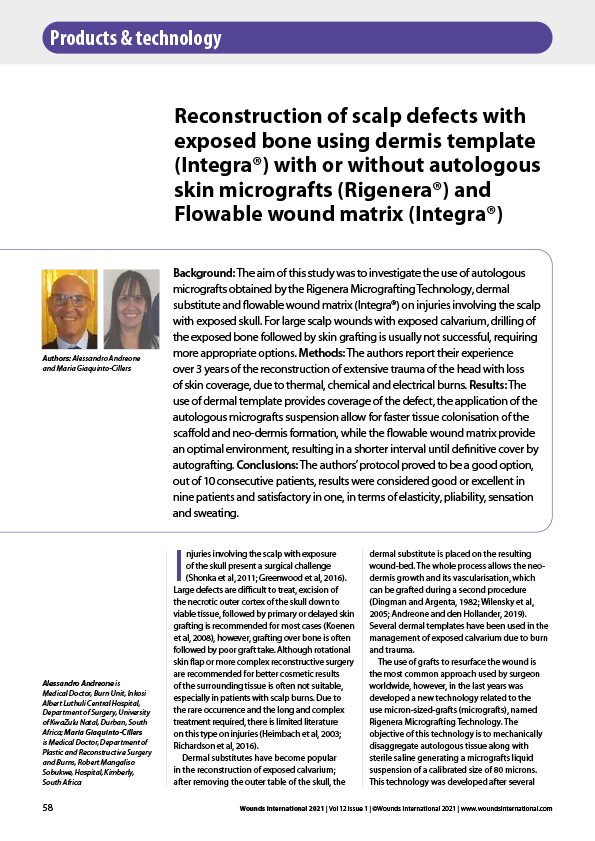
Background: The aim of this study was to investigate the use of autologous micrografts obtained by the Rigenera Micrografting Technology, dermal substitute and flowable wound matrix (Integra®) on injuries involving the scalp with exposed skull. For large scalp wounds with exposed calvarium, drilling of the exposed bone followed by skin grafting is usually not successful, […]
Wounds digest
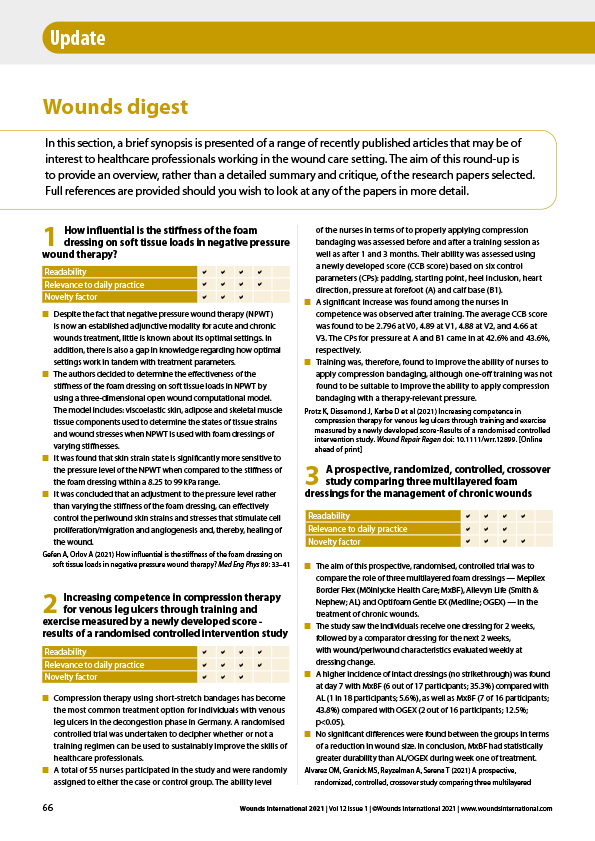
In this section, a brief synopsis is presented of a range of recently published articles that may be of interest to healthcare professionals working in the wound care setting. The aim of this round-up is to provide an overview, rather than a detailed summary and critique, of the research papers selected. Full references are provided […]
Incision care and dressing selection in surgical wounds: Findings from an international meeting in the APAC region
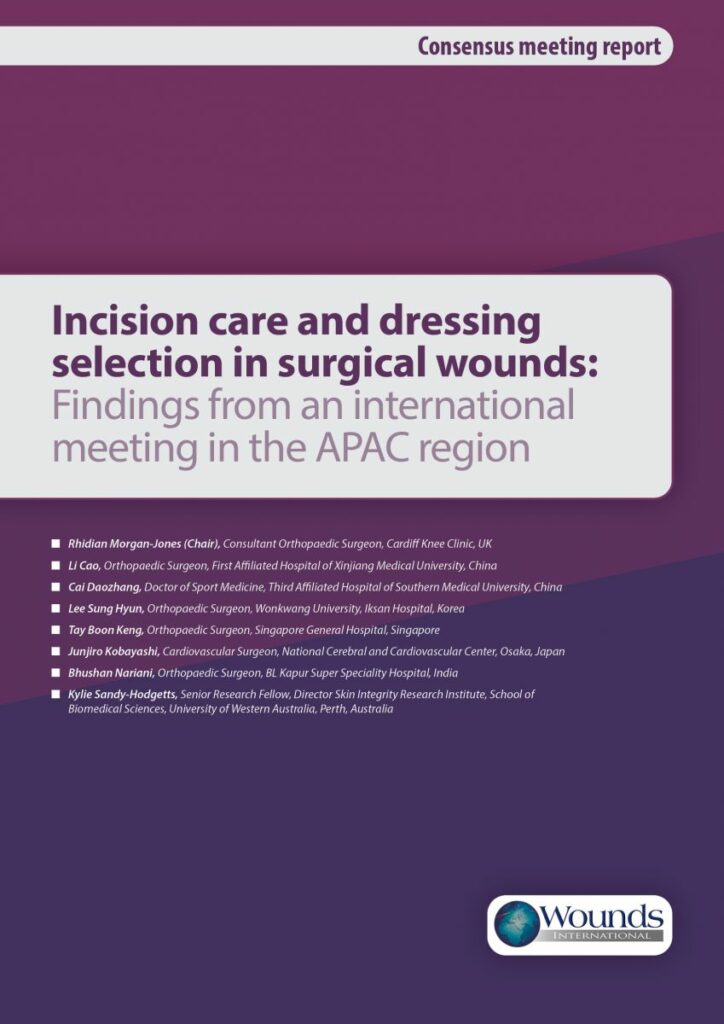
This report highlights the findings of a meeting of key opinion leaders (KOLs) from the Asia-Pacific region, chaired by Rhidian Morgan-Jones (UK), to discuss incision care and dressing selection in surgical wounds. The meeting was held online in November 2020 and was supported by Mölnlycke Health Care.
Preventing and treating infection in wounds: translating evidence and recommendations into practice
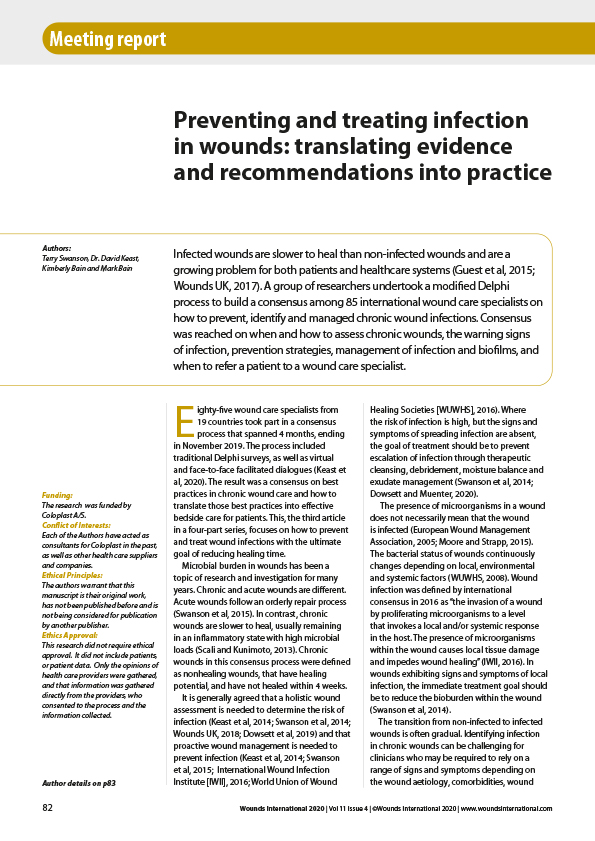
Infected wounds are slower to heal than non-infected wounds and are a growing problem for both patients and healthcare systems (Guest et al, 2015; Wounds UK, 2017). A group of researchers undertook a modified Delphi process to build a consensus among 85 international wound care specialists on how to prevent, identify and managed chronic wound […]
Wounds digest
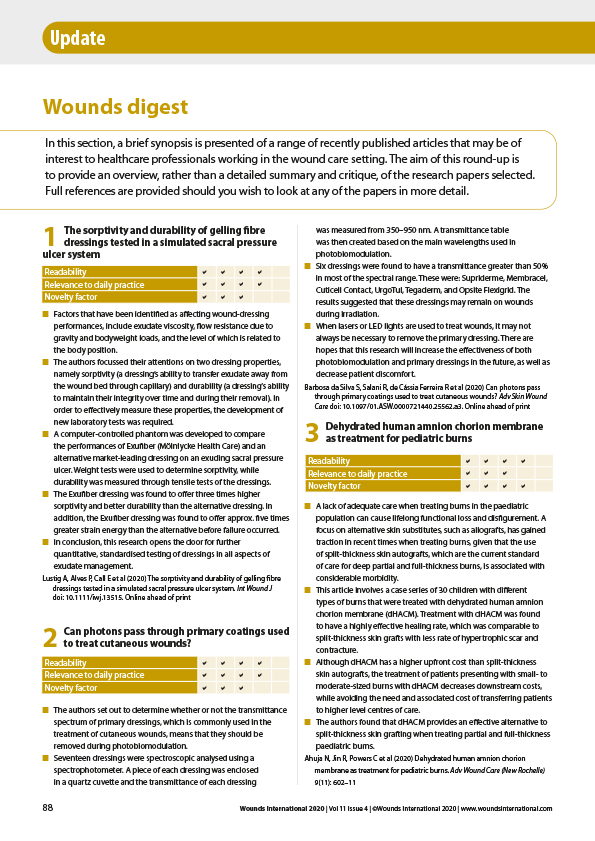
In this section, a brief synopsis is presented of a range of recently published articles that may be of interest to healthcare professionals working in the wound care setting. The aim of this round-up is to provide an overview, rather than a detailed summary and critique, of the research papers selected. Full references are provided […]
Hope is on the horizon
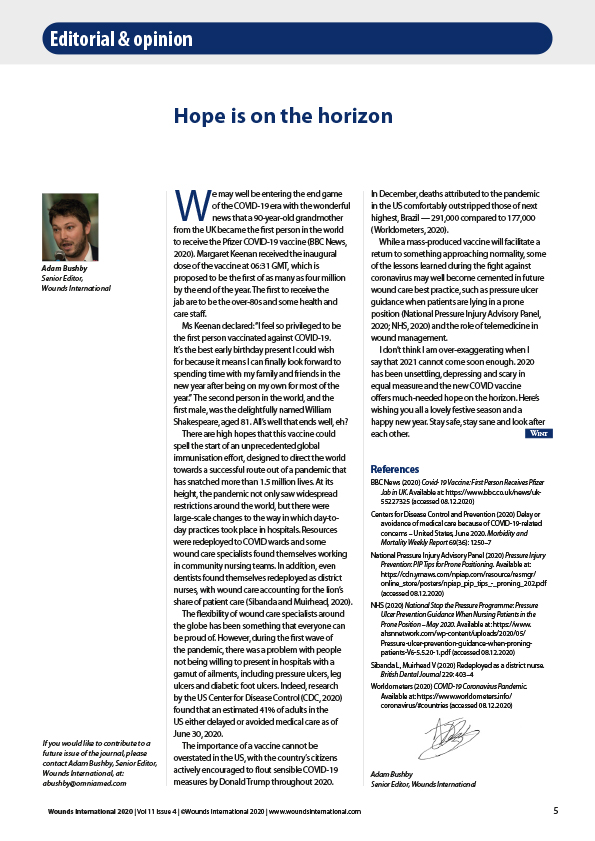
We may well be entering the end game of the COVID-19 era with the wonderful news that a 90-year-old grandmother from the UK became the first person in the world to receive the Pfizer COVID-19 vaccine (BBC News, 2020). Margaret Keenan received the inaugural dose of the vaccine at 06:31 GMT, which is proposed to […]
Recovering from COVID-19
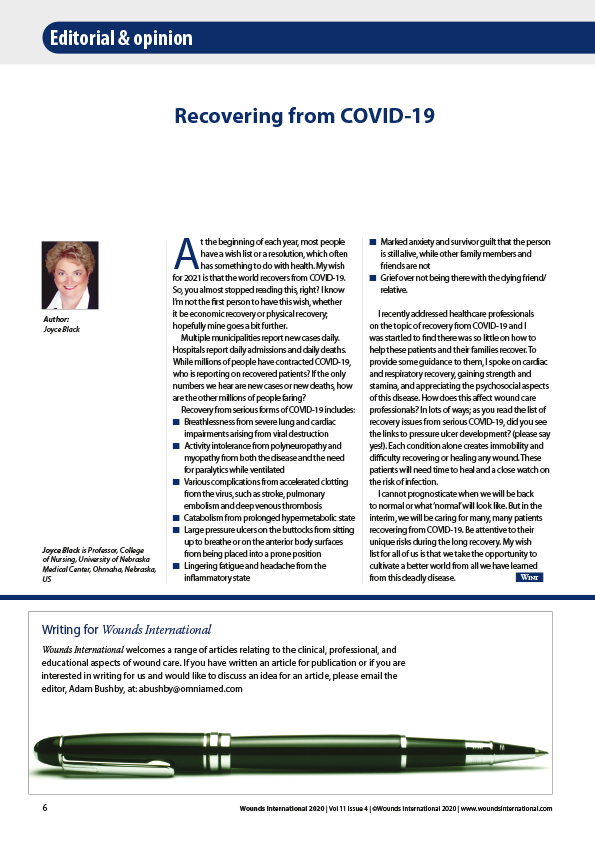
At the beginning of each year, most people have a wish list or a resolution, which often has something to do with health. My wish for 2021 is that the world recovers from COVID-19. So, you almost stopped reading this, right? I know I’m not the first person to have this wish, whether it be […]
Ten top tips: managing wound odour
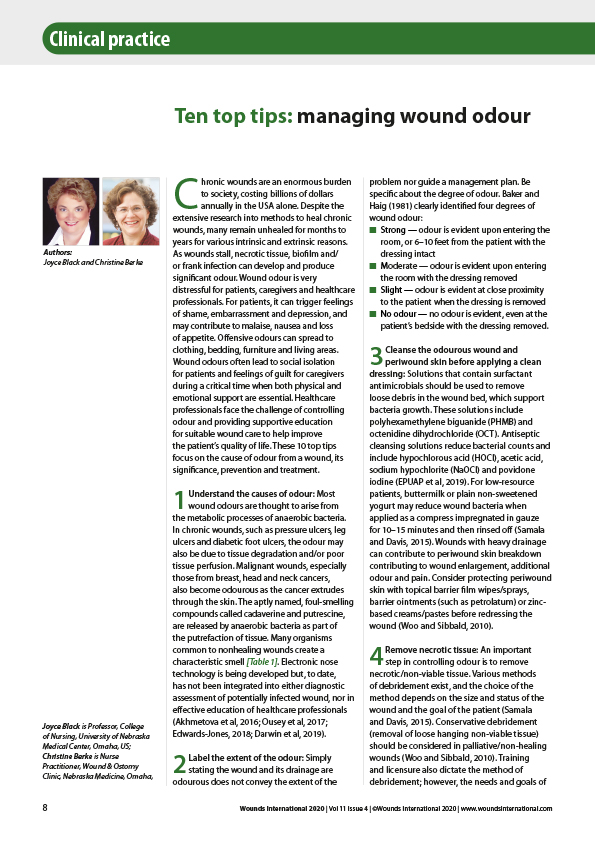
Chronic wounds are an enormous burden to society, costing billions of dollars annually in the USA alone. Despite the extensive research into methods to heal chronic wounds, many remain unhealed for months to years for various intrinsic and extrinsic reasons. As wounds stall, necrotic tissue, biofilm and/ or frank infection can develop and produce significant […]
Effect of high negative pressure wound therapy in diabetic foot ulcer healing
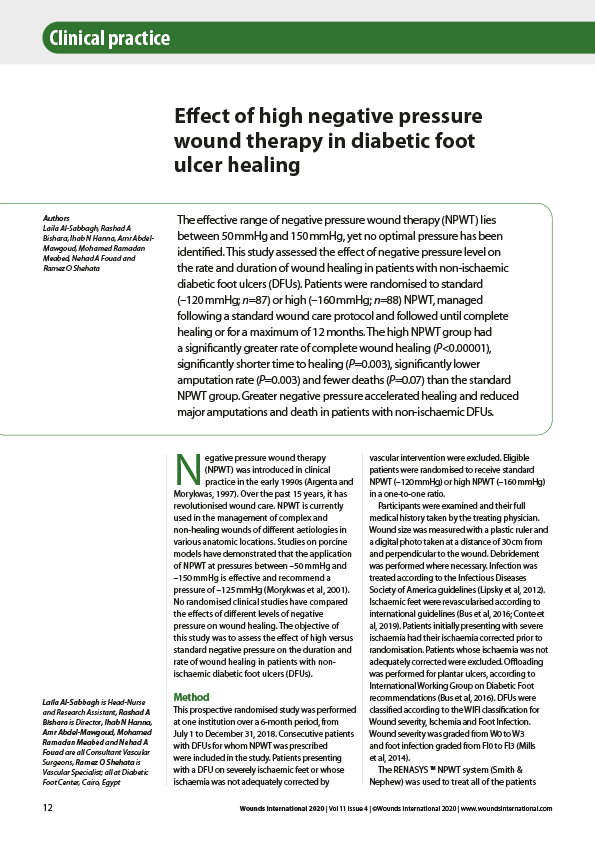
The effective range of negative pressure wound therapy (NPWT) lies between 50 mmHg and 150 mmHg, yet no optimal pressure has been identified. This study assessed the effect of negative pressure level on the rate and duration of wound healing in patients with non-ischaemic diabetic foot ulcers (DFUs). Patients were randomised to standard (–120 mmHg; […]
Management of burn patients with Technology Lipido-Colloid with silver sulphate to fight local infection and restore the healing process
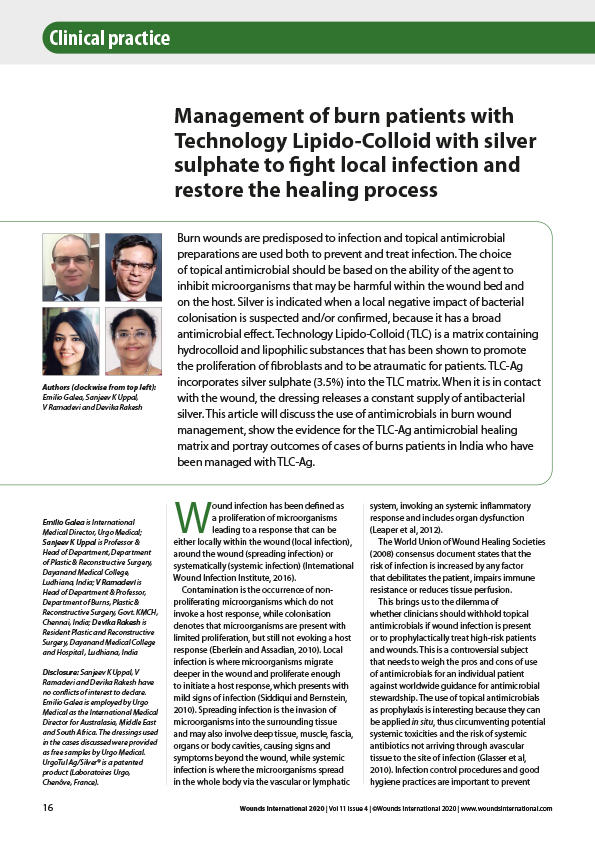
Burn wounds are predisposed to infection and topical antimicrobial preparations are used both to prevent and treat infection. The choice of topical antimicrobial should be based on the ability of the agent to inhibit microorganisms that may be harmful within the wound bed and on the host. Silver is indicated when a local negative impact […]
The SEM Scanner for early pressure ulcer detection: a 360-degree review of the technology
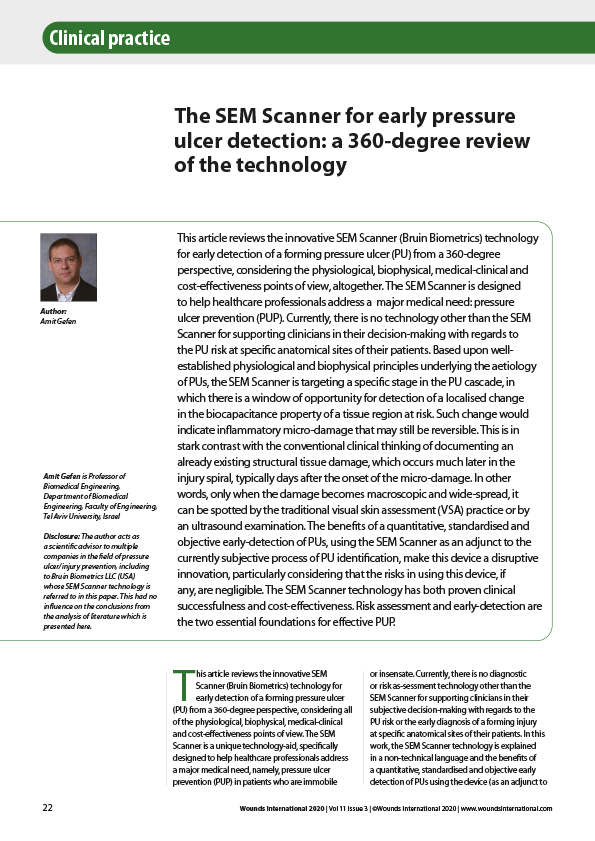
This article reviews the innovative SEM Scanner (Bruin Biometrics) technology for early detection of a forming pressure ulcer (PU) from a 360-degree perspective, considering the physiological, biophysical, medical-clinical and cost-effectiveness points of view, altogether. The SEM Scanner is designed to help healthcare professionals address a major medical need: pressure ulcer prevention (PUP). Currently, there is […]
Predictive validity of Amit Jain’s screening tool in estimating the risk of complications in diabetic foot — a retrospective cohort study
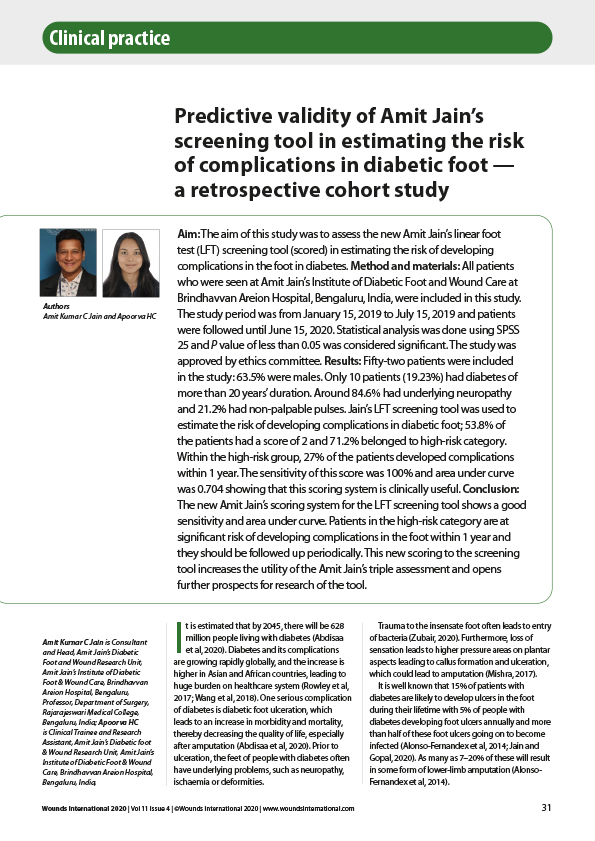
Aim: The aim of this study was to assess the new Amit Jain’s linear foot test (LFT) screening tool (scored) in estimating the risk of developing complications in the foot in diabetes. Method and materials: All patients who were seen at Amit Jain’s Institute of Diabetic Foot and Wound Care at Brindhavvan Areion Hospital, Bengaluru, […]
The pathophysiological links between pressure ulcers and pain and the role of the support surface in mitigating both
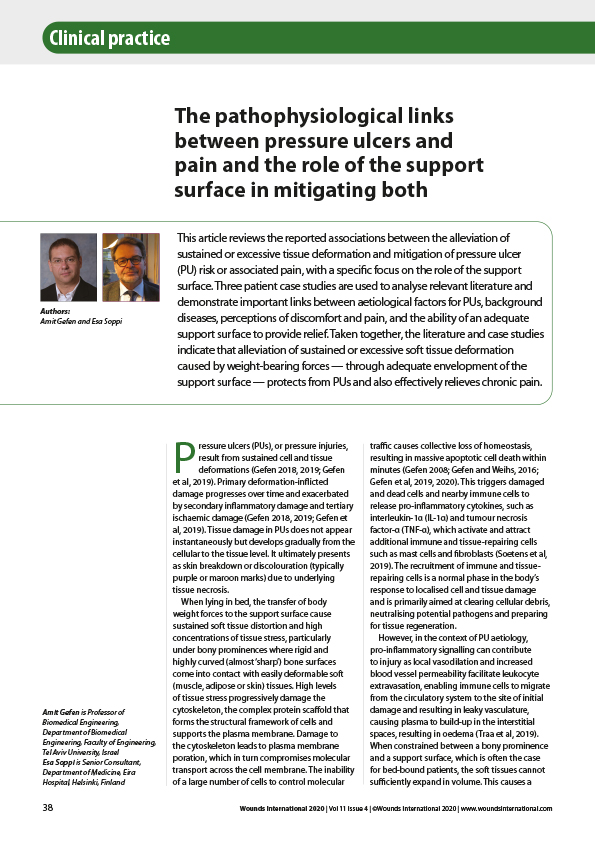
This article reviews the reported associations between the alleviation of sustained or excessive tissue deformation and mitigation of pressure ulcer (PU) risk or associated pain, with a specific focus on the role of the support surface. Three patient case studies are used to analyse relevant literature and demonstrate important links between aetiological factors for PUs, […]
Contribution of photonic therapies to the healing process of chronic wounds: case studies
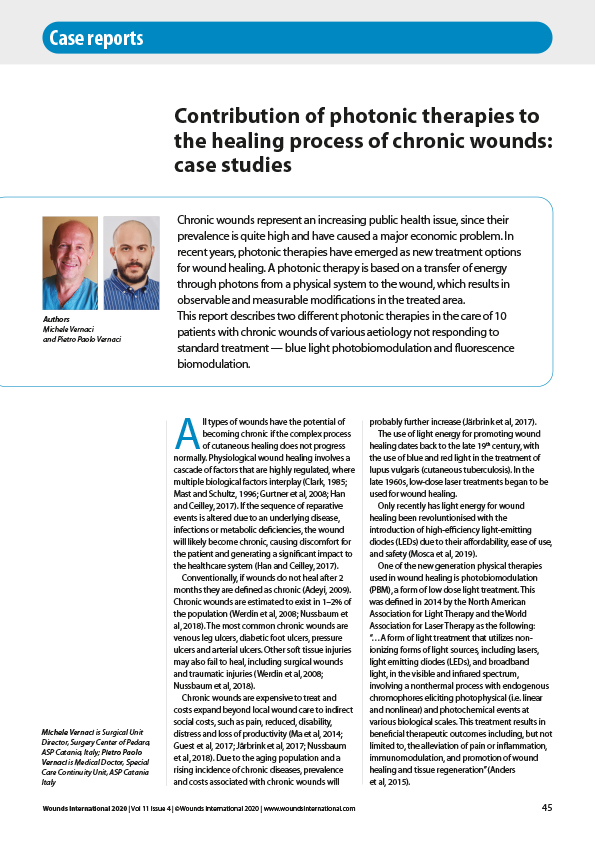
Chronic wounds represent an increasing public health issue, since their prevalence is quite high and have caused a major economic problem. In recent years, photonic therapies have emerged as new treatment options for wound healing. A photonic therapy is based on a transfer of energy through photons from a physical system to the wound, which […]
Implementing the new Infection Management Pathway to optimise outcomes: real-world case series
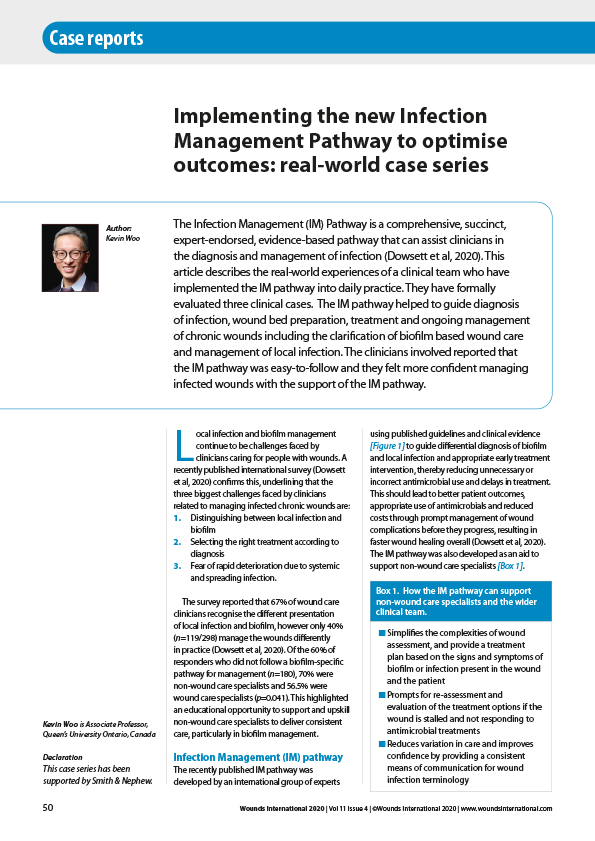
The Infection Management (IM) Pathway is a comprehensive, succinct, expert-endorsed, evidence-based pathway that can assist clinicians in the diagnosis and management of infection (Dowsett et al, 2020). This article describes the real-world experiences of a clinical team who have implemented the IM pathway into daily practice. They have formally evaluated three clinical cases. The IM […]
The impact of psychological factors on wound healing
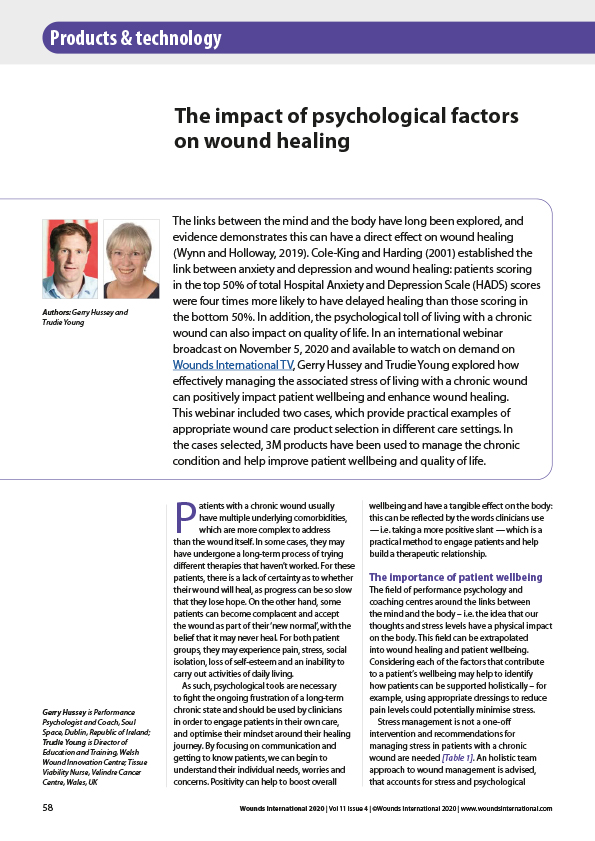
The links between the mind and the body have long been explored, and evidence demonstrates this can have a direct effect on wound healing (Wynn and Holloway, 2019). Cole-King and Harding (2001) established the link between anxiety and depression and wound healing: patients scoring in the top 50% of total Hospital Anxiety and Depression Scale […]
Silicone therapy for the treatment and prevention of problematic scars: a practical guideline
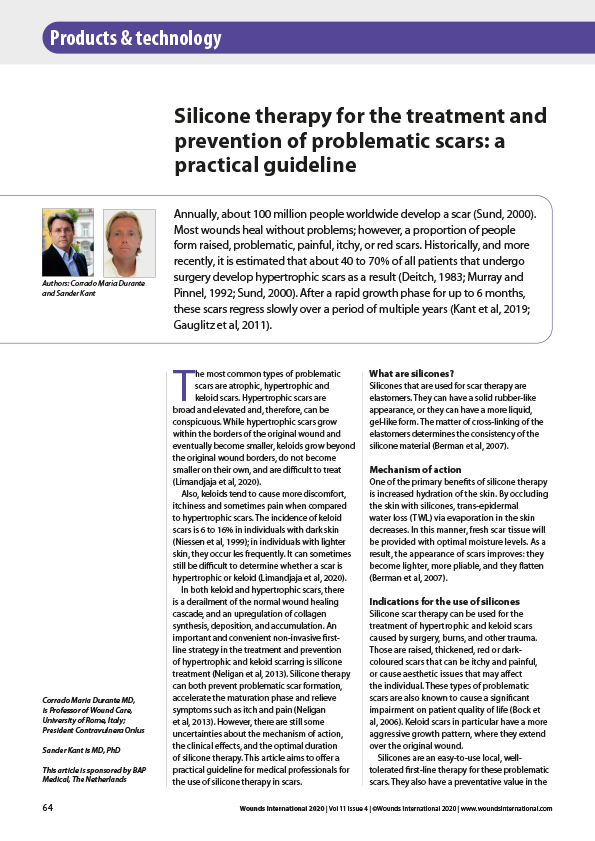
Annually, about 100 million people worldwide develop a scar (Sund, 2000). Most wounds heal without problems; however, a proportion of people form raised, problematic, painful, itchy, or red scars. Historically, and more recently, it is estimated that about 40 to 70% of all patients that undergo surgery develop hypertrophic scars as a result (Deitch, 1983; […]
Advancing practice in holistic wound management: a consensus-based call to action
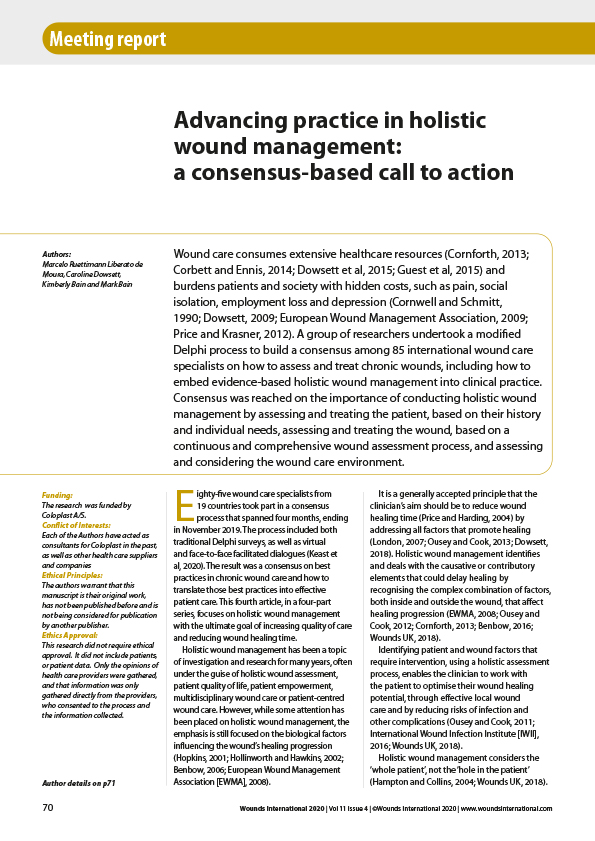
Wound care consumes extensive healthcare resources (Cornforth, 2013; Corbett and Ennis, 2014; Dowsett et al, 2015; Guest et al, 2015) and burdens patients and society with hidden costs, such as pain, social isolation, employment loss and depression (Cornwell and Schmitt, 1990; Dowsett, 2009; European Wound Management Association, 2009; Price and Krasner, 2012). A group of […]
Non-medicated wound dressings in managing infected wounds and wounds with biofilms
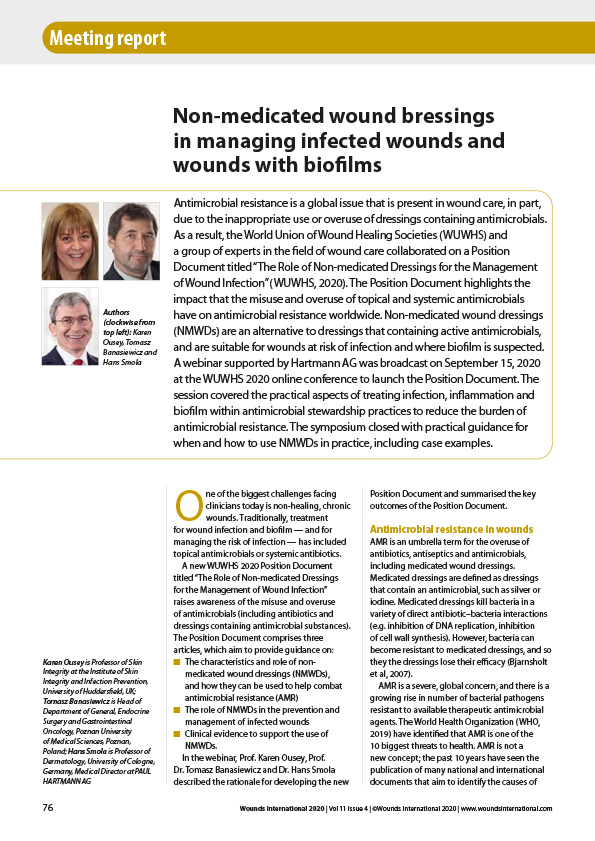
Antimicrobial resistance is a global issue that is present in wound care, in part, due to the inappropriate use or overuse of dressings containing antimicrobials. As a result, the World Union of Wound Healing Societies (WUWHS) and a group of experts in the field of wound care collaborated on a Position Document titled “The Role […]
Demystifying mild, moderate and high compression systems – when and how to introduce “lighter” compression
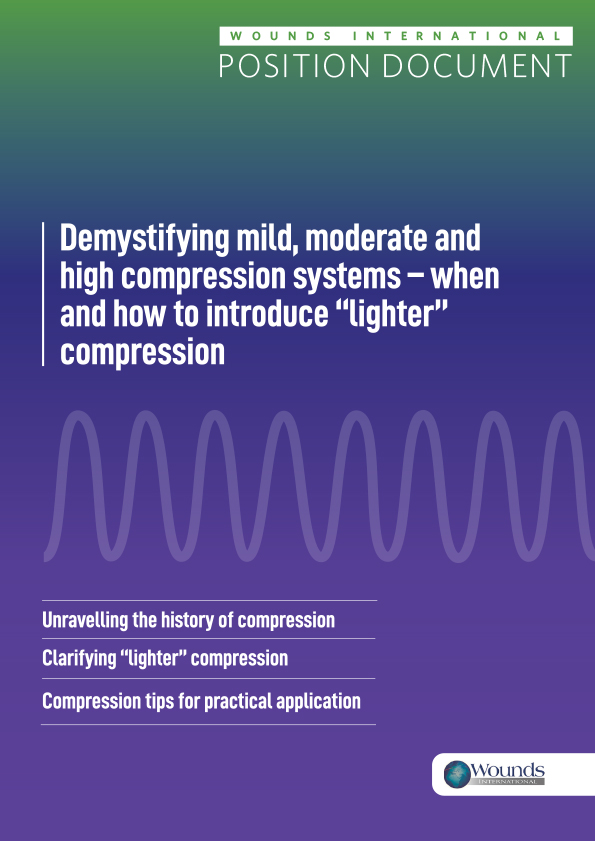
Compression therapy remains the treatment of choice for venous leg ulcers and, in mixed ulcer aetiology, mild compression has an important role in treatment, increasing both venous return and improving arterial perfusion. However, data would indicate that the tools required to assess patients before the application of compression, such as the Ankle Brachial Pressure Index […]
Best practice recommendations: Prevention and management of Moisture-associated skin damage (MASD)
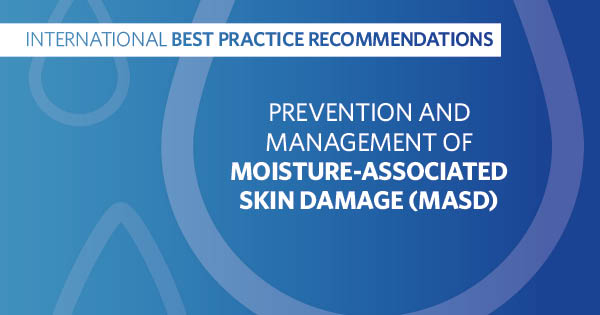
Moisture-associated skin damage (MASD) represents a significant problem and can have a negative effect on patient wellbeing and quality of life. A group of international experts met online via Zoom in June 2020 to discuss the key issues and knowledge gaps in MASD, and to formulate Best Practice Statements to guide the prevention and management […]
In it for the long haul
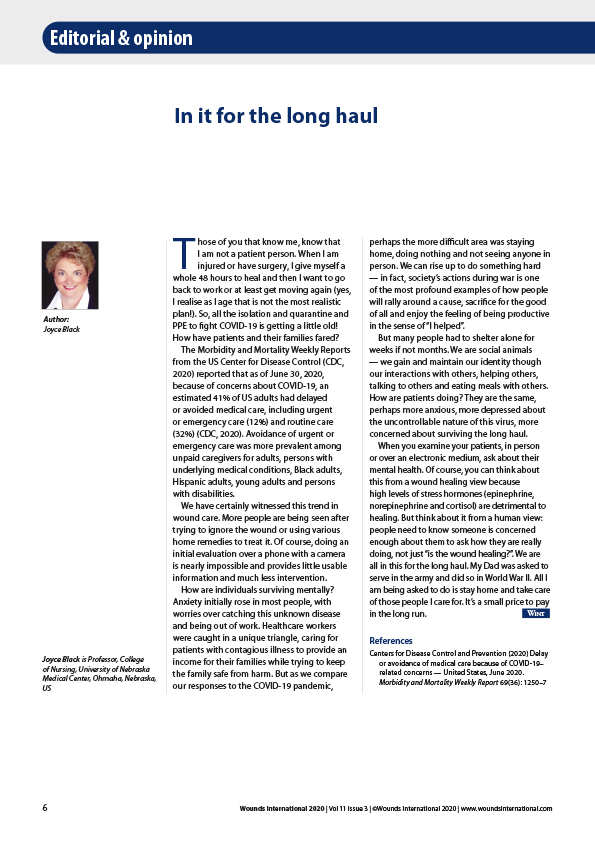
Those of you that know me, know that I am not a patient person. When I am injured or have surgery, I give myself a whole 48 hours to heal and then I want to go back to work or at least get moving again (yes, I realise as I age that is not the […]
A new reinforced gelling fibre to reduce exudate pooling: Biatain® Fiber with HexaLock® Technology
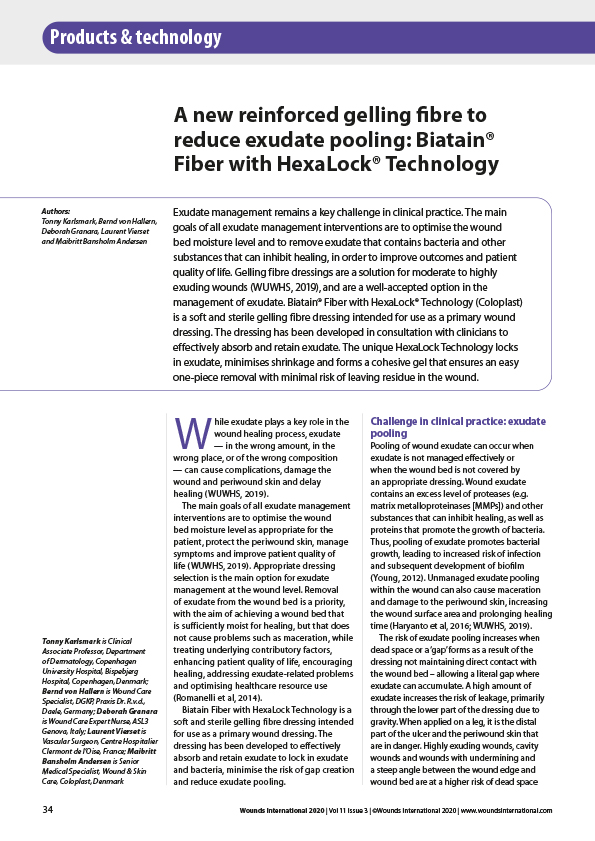
Exudate management remains a key challenge in clinical practice. The main goals of all exudate management interventions are to optimise the wound bed moisture level and to remove exudate that contains bacteria and other substances that can inhibit healing, in order to improve outcomes and patient quality of life. Gelling fibre dressings are a solution […]
Managing highly exuding wounds — removing the risk of infection
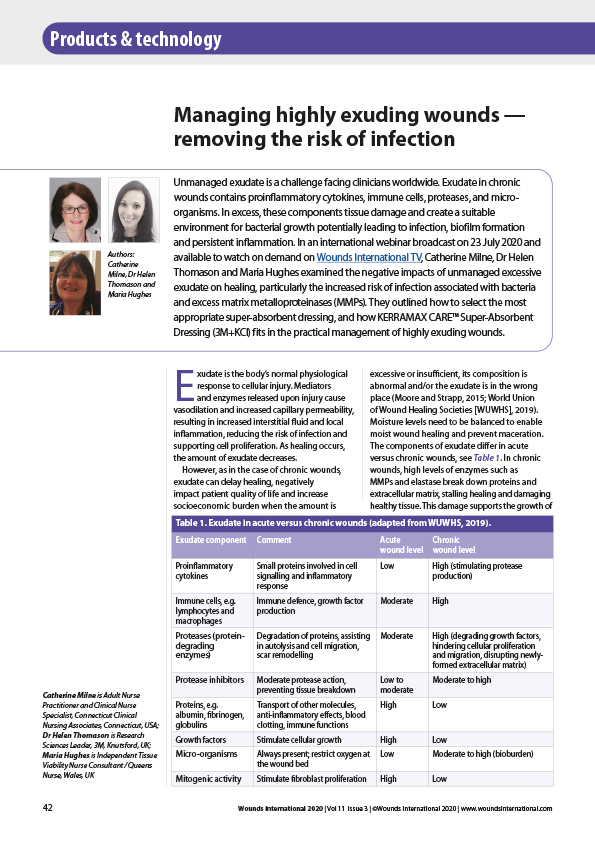
Unmanaged exudate is a challenge facing clinicians worldwide. Exudate in chronic wounds contains proinflammatory cytokines, immune cells, proteases, and microorganisms. In excess, these components tissue damage and create a suitable environment for bacterial growth potentially leading to infection, biofilm formation and persistent inflammation. In an international webinar broadcast on 23 July 2020 and available to […]
A route to more effective infection management: The Infection Management Pathway
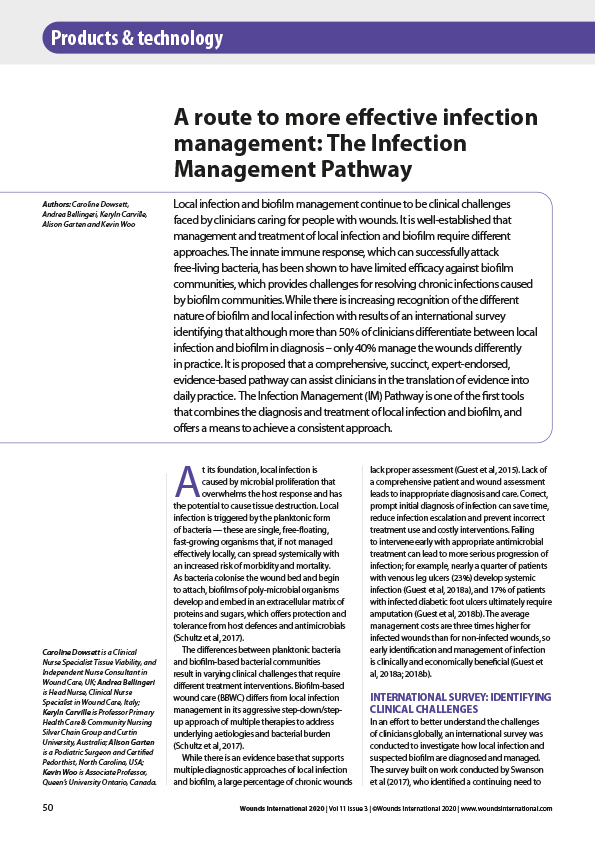
Local infection and biofilm management continue to be clinical challenges faced by clinicians caring for people with wounds. It is well-established that management and treatment of local infection and biofilm require different approaches. The innate immune response, which can successfully attack free-living bacteria, has been shown to have limited efficacy against biofilm communities, which provides […]
Managing the gap to promote healing in chronic wounds — an international consensus
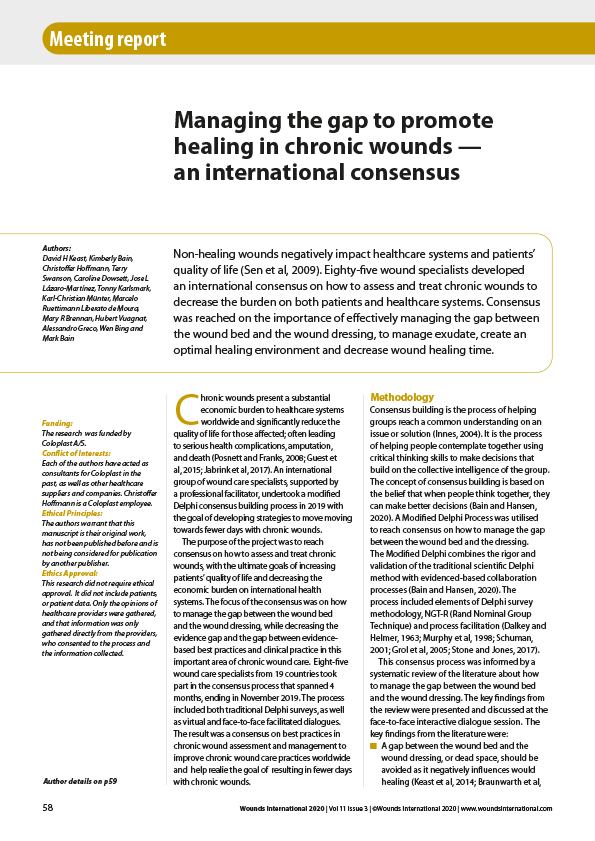
Non-healing wounds negatively impact healthcare systems and patients’ quality of life (Sen et al, 2009). Eighty-five wound specialists developed an international consensus on how to assess and treat chronic wounds to decrease the burden on both patients and healthcare systems. Consensus was reached on the importance of effectively managing the gap between the wound bed […]
Closing the gap between the evidence and clinical practice — a consensus report on exudate management
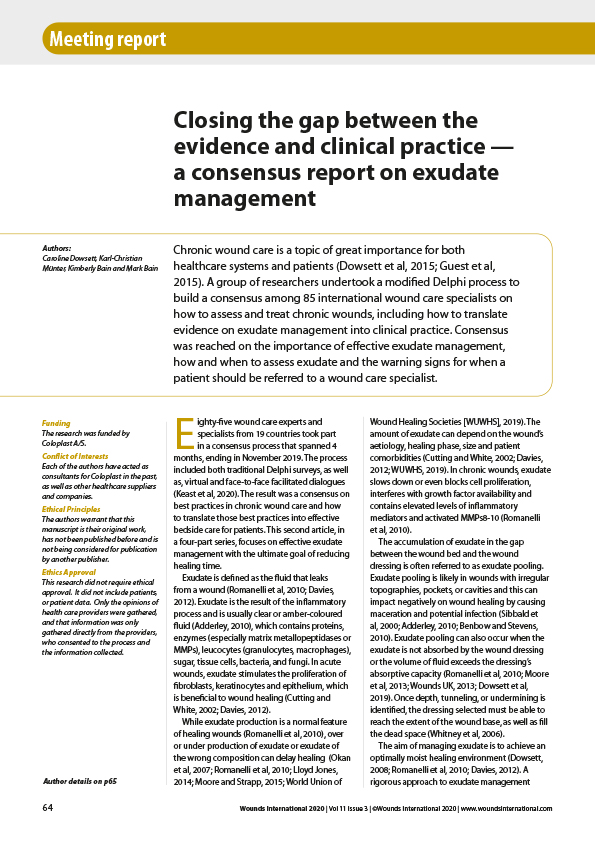
Chronic wound care is a topic of great importance for both healthcare systems and patients (Dowsett et al, 2015; Guest et al, 2015). A group of researchers undertook a modified Delphi process to build a consensus among 85 international wound care specialists on how to assess and treat chronic wounds, including how to translate evidence […]
Ten top tips: assessing darkly pigmented skin
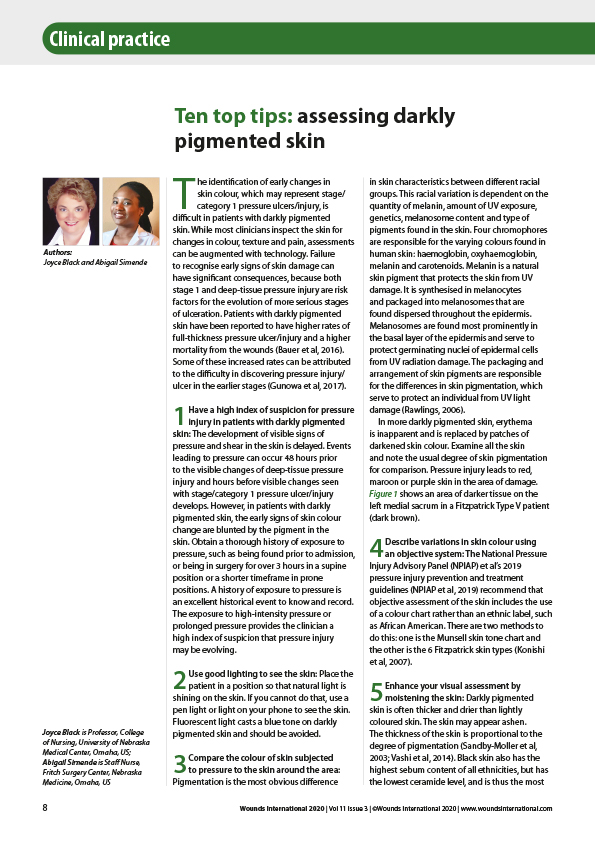
The identification of early changes in skin colour, which may represent stage/ category 1 pressure ulcers/injury, is difficult in patients with darkly pigmented skin. While most clinicians inspect the skin for changes in colour, texture and pain, assessments can be augmented with technology. Failure to recognise early signs of skin damage can have significant consequences, […]
Preliminary review: should venous leg ulcers be considered healed or in remission?
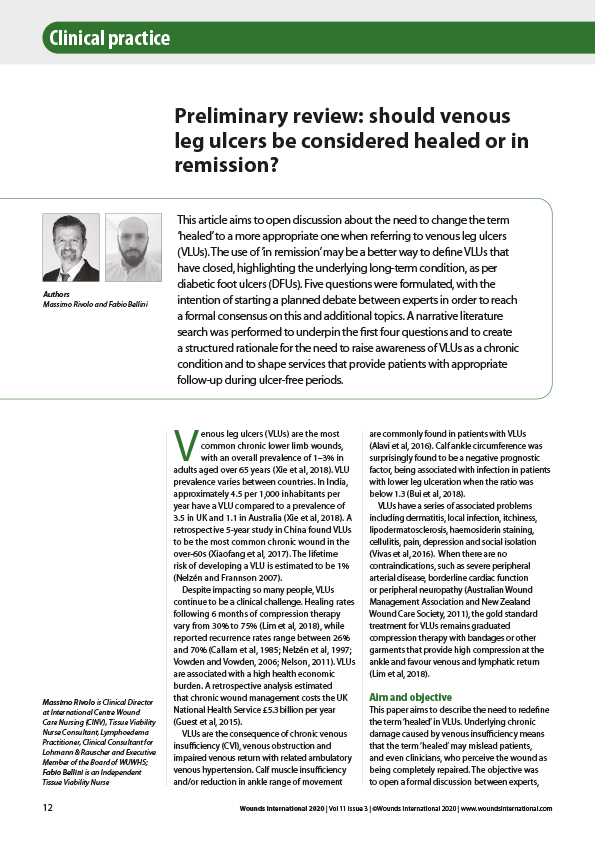
This article aims to open discussion about the need to change the term ‘healed’ to a more appropriate one when referring to venous leg ulcers (VLUs). The use of ’in remission’ may be a better way to define VLUs that have closed, highlighting the underlying long-term condition, as per diabetic foot ulcers (DFUs). Five questions […]
The impact of COVID-19 on wound care provision in South Africa: a personal account
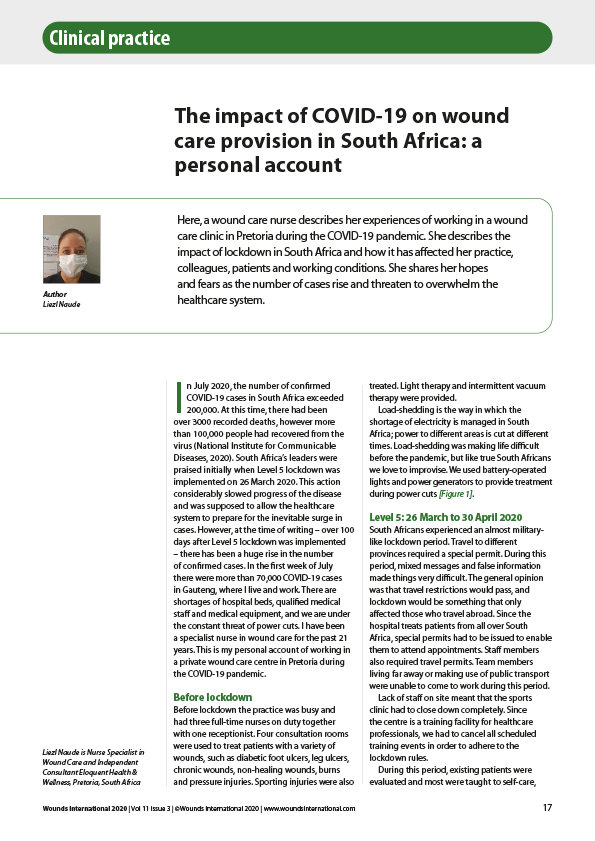
Here, a wound care nurse describes her experiences of working in a wound care clinic in Pretoria during the COVID-19 pandemic. She describes the impact of lockdown in South Africa and how it has affected her practice, colleagues, patients and working conditions. She shares her hopes and fears as the number of cases rise and […]
Location of lower-extremity diabetic foot ulcers with concomitant arterial or venous disease
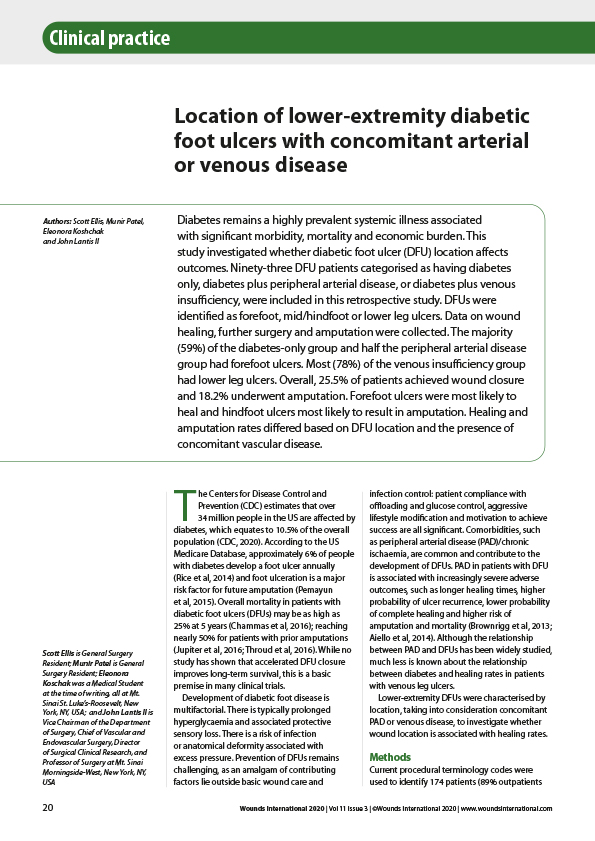
Diabetes remains a highly prevalent systemic illness associated with significant morbidity, mortality and economic burden. This study investigated whether diabetic foot ulcer (DFU) location affects outcomes. Ninety-three DFU patients categorised as having diabetes only, diabetes plus peripheral arterial disease, or diabetes plus venous insufficiency, were included in this retrospective study. DFUs were identified as forefoot, […]
A qualitative analysis of an evidencebased lymphoedema booklet for melanoma patients
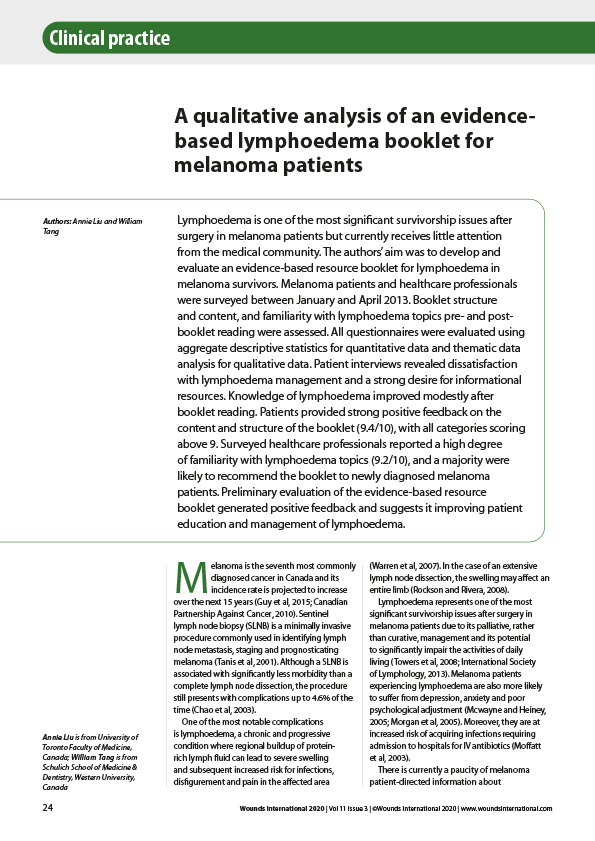
Lymphoedema is one of the most significant survivorship issues after surgery in melanoma patients but currently receives little attention from the medical community. The authors’ aim was to develop and evaluate an evidence-based resource booklet for lymphoedema in melanoma survivors. Melanoma patients and healthcare professionals were surveyed between January and April 2013. Booklet structure and […]
Transcutaneous electrical nerve stimulation to treat pain in patients with venous leg ulceration
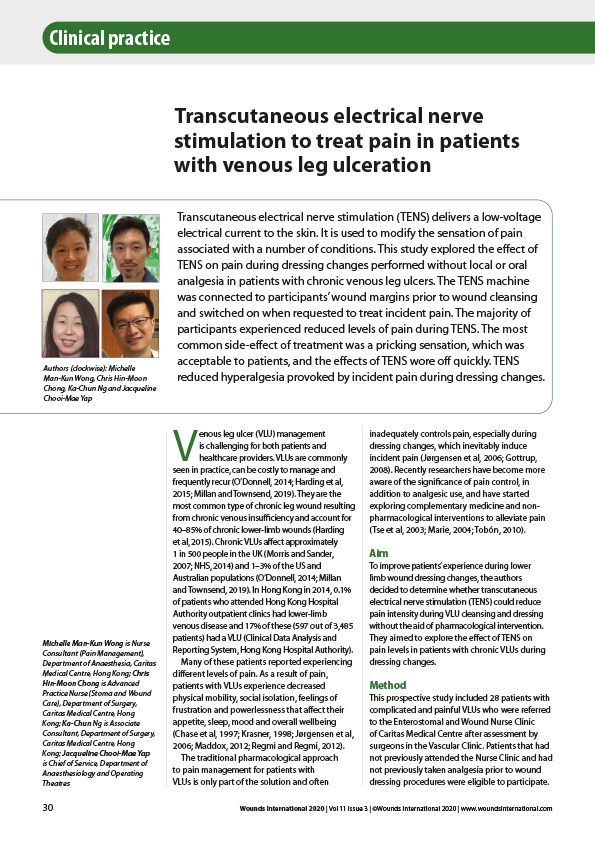
Transcutaneous electrical nerve stimulation (TENS) delivers a low-voltage electrical current to the skin. It is used to modify the sensation of pain associated with a number of conditions. This study explored the effect of TENS on pain during dressing changes performed without local or oral analgesia in patients with chronic venous leg ulcers. The TENS […]
Wounds digest
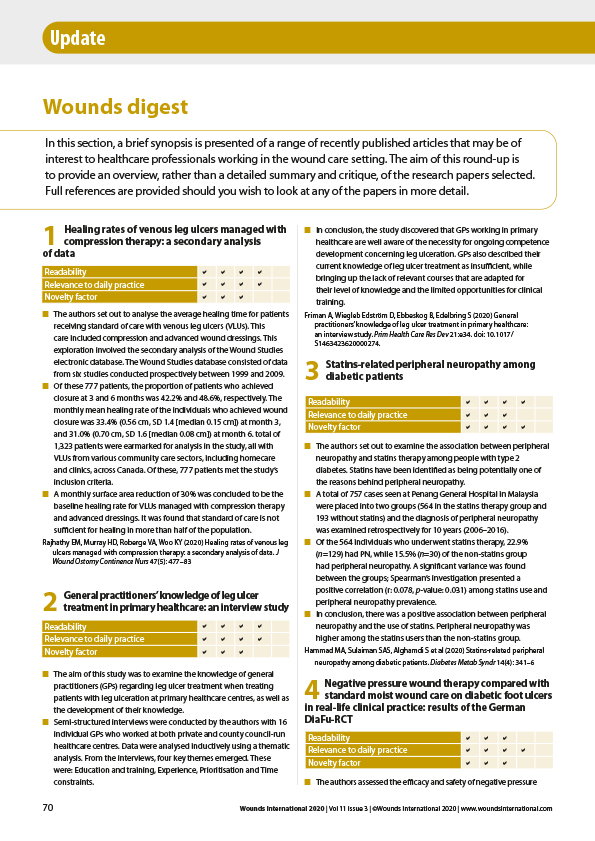
In this section, a brief synopsis is presented of a range of recently published articles that may be of interest to healthcare professionals working in the wound care setting. The aim of this round-up is to provide an overview, rather than a detailed summary and critique, of the research papers selected. Full references are provided […]
Retrospective case series: Wounds treated with 3M™ Veraflo™ Therapy
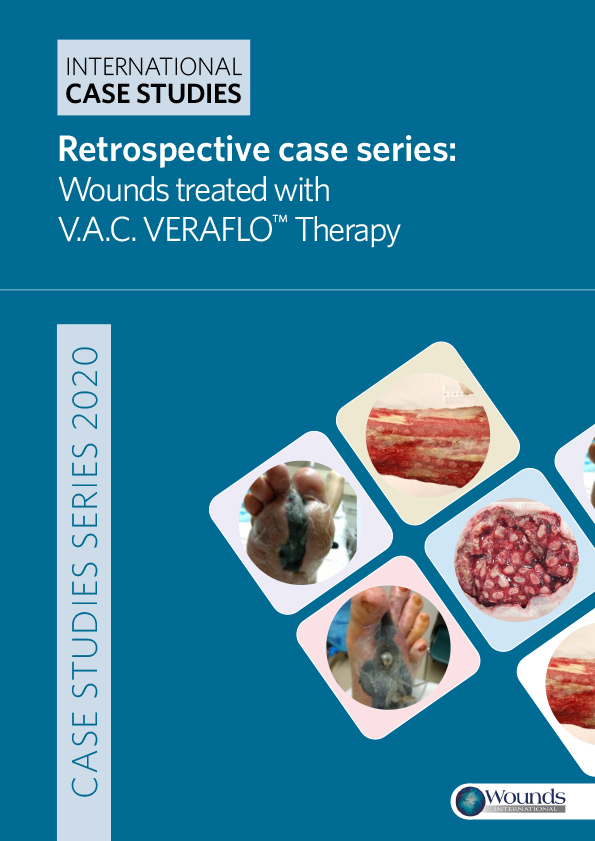
Delayed wound healing remains a key challenge in clinical practice, with hard-to-heal wounds resulting in pain, morbidity, prolonged treatment, and in some instances requiring major reconstructive surgery (Agarwal et al, 2019). If wound healing is delayed for a substantial amount of time, this can be a challenge for clinical teams with regards to increasing complications, […]
The role of non-medicated dressings for the management of wound infection
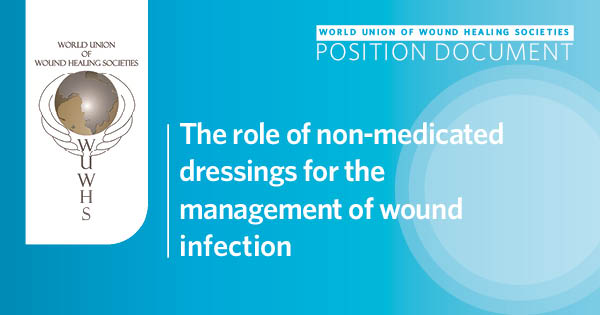
There is growing concern regarding the treatment of infection, caused by the rise of antimicrobial resistance. This position document looks at current treatment approaches to identifying and treating biofilm in wounds, focusing on the mechanism of action and role of non-medicated wound dressings (NMWDs) within antimicrobial stewardship practices and evidence that supports their effectiveness. Supported […]
Evidence in wound care
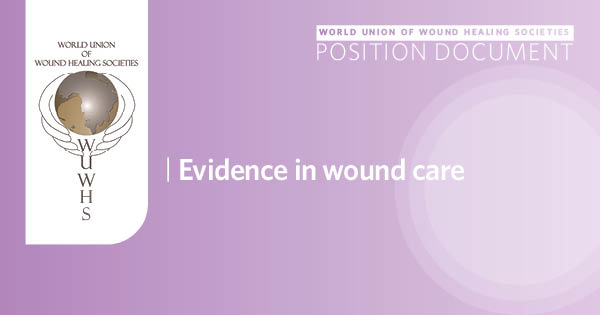
There is an ever-growing variety of products and devices available to practitioners to improve healing rates and patient outcomes, but practitioners should be able to critically appraise evidence to make appropriate evidence-based changes to practice. This position document reviews the available evidence in wound care, looking especially at the critical appraisal of level 1 evidence, […]
Optimising wound care through patient engagement
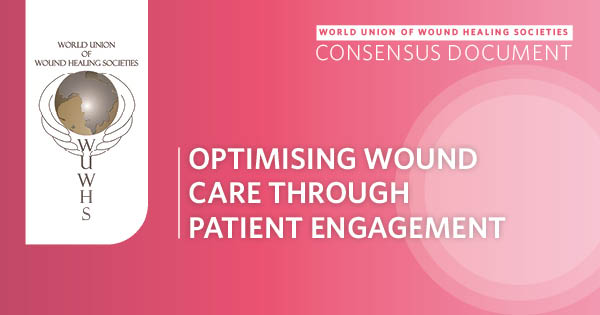
Patient engagement is a crucial and timely topic, both in terms of wound healing (and, in some cases, symptom management), and in improving individuals’ experiences of the process. This document aims to provide clear guidance in listening and engaging with individuals, and thus optimising the care experience for all key stakeholders, of which the patient […]
Strategies to reduce practice variation in wound assessment and management: The T.I.M.E. Clinical Decision Support Tool
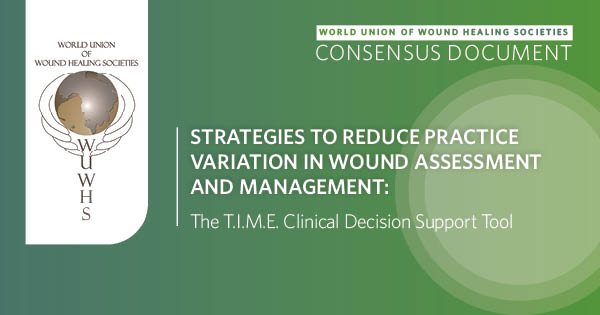
This document seeks to help clinicians support those who do not have specialist wound training to accurately assess patients and their wounds and arrive at a broad-based, systematic rationale that will ultimately help reduce variations in clinical decision-making. The T.I.M.E. Clinical Decision Support Tool provides a structured approach to wound bed preparation. Supported by an […]
Quick Guide: Pathway to support wound healing using the PROMOGRAN™ Matrix Family
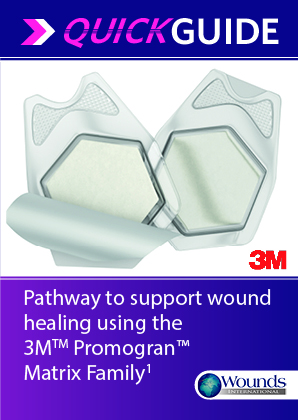
Use of PROMOGRAN™ Matrix and PROMOGRAN PRISMA™ Matrix is beneficial in managing the underlying biochemistry of chronic wounds. Educational support should be provided to healthcare professionals before the introduction of these dressings and for their use to be monitored in practice and outcomes of care measured. PROMOGRAN™ Matrix and PROMOGRAN PRISMA™ Matrix should be considered […]
Using telehealth to support self-management of lymphoedema: clinicians’ and patients’ perspectives
Background: People with lymphoedema are commonly required to self-manage their condition. Telehealth may offer a way for clinicians to support self-management. Aim: To explore clinicians’ and patients’ perspectives relating to telehealth for lymphoedema management. Methods: Semistructured interviews were conducted with 21 clinicians and 19 people with lymphoedema, in Australia. Data were coded independently by three coders, then grouped […]
Knowledge base of wound, ostomy and incontinence nurses regarding lymphoedema: management and treatment in Brazil — results of a survey
Background: Lymphoedema is a result of lymphatic drainage deficit and lymphatic system overload, which affects over 200 million people throughout the world. This condition can interfere with the individual’s life, with stigma and disability associated with economic, physical and psychosocial consequences. Despite its incidence and prevalence in our populations, healthcare providers still have limited knowledge of […]
The impact of land-based exercise on quality of life and subjective symptoms in lowerlimb lymphoedema: a systematic review
Chronic lower-limb lymphoedema disrupts physical and mental health and requires labour-intensive therapies. This review synthesised evidence on the impact of exercise therapy on sufferer quality of life and symptom experience, concluding that exercise may improve strength, fitness, function, and decrease fatigue. It might also improve quality of life and subjective symptom scores, or at least […]
Awareness and attitudes of lymphoedema patients toward compression stockings in the summer: a cross-sectional questionnaire survey
Background: Patients with leg lymphoedema are often concerned about wearing compression stockings when the ambient temperature is high during summer. This study explored patient attitudes with regard to their use of compression stockings. Method: This was a cross-sectional survey via a self-administered questionnaire for 1,000 patients. Questions related to patient characteristics, awareness, issues with compression stockings during summer […]
The incidence and effects of lower-limb lymphoedema in women treated with radiotherapy for gynaecological cancer in South Africa
Despite the high incidence of gynaecological cancer in South Africa, the incidence of lower-limb lymphoedema is unknown. This study used a cross-sectional design, circumference measurements, limb volumes and the Gynaecological Cancer Lymphedema Questionnaire (GCLQ), to describe the incidence, symptoms and effects of lymphedema (n=155). Nearly 30% (29.7%; n=46) of the sample (n=155) developed lower-limb lymphoedema […]
Living with lymphoedema and obesity: Implications for training, communication, and management considerations
Background: Excess weight is associated with an increased risk of lymphoedema in patients with breast cancer. Studies are lacking about the experiences of patients with comorbid lymphoedema and obesity. Aims: This study aimed to examine lymphoedema knowledge, management barriers and impact on wellbeing in those with lymphoedema and obesity. Methods: Twenty-six patients (10 male and 16 female) with a mean […]
Lymphoedema practice patterns: the current state of the industry
Lymphoedema practitioners were surveyed by the Lymphology Association of North America (LANA) in 2019 to provide a snapshot of contemporary practice patterns in the management of patients diagnosed with lymphoedema and related disorders. The State of the Industry Survey respondents (n=860) were physical (47%), occupational (31%), and massage (12%) therapists, physical therapist assistants (6%) and […]
Efficacy of Kinesio® taping in the treatment of lymphoedema after breast cancer: a systematic review
It is estimated that up to 20% of patients diagnosed with breast cancer will suffer from lymphoedema after surgery and associated treatments. Recently, Kinesio® taping has been integrated with other modalities as an additional technique in the treatment of breast cancerrelated lymphoedema. This review aimed to determine whether Kinesio® taping is an effective technique in the treatment […]
Positive outcomes with Legassist compression garments treating advanced, Stage 3 lymphoedema and deleterious consequences of coverage denials
This case study is an example of one patient’s journey spanning many decades where denials of proper compression garments resulted in a cascade of failed surgeries, nonhealing post-surgical wounds, recurrent cellulitis infections and extended hospitalisations. As her primary lymphoedema progressed to Stage 3 elephantiasis with massive localised lobules, depression and hopelessness set in. Once she […]
Chylous ascites, genital and lower-limb lymphoedema: a case report
There is evidence in the literature of clinicians dealing with either lymphoedema or chylous ascites (CA), but associations between these conditions are rarely discussed. This paper aims to highlight the importance of teamwork and information exchange in the multidisciplinary approach of a case of CA with lymphoedema. A seventy-four-year-old woman was referred to the Lymphoedema […]


